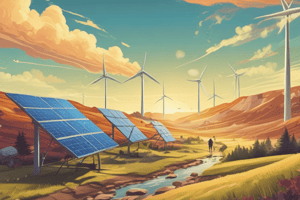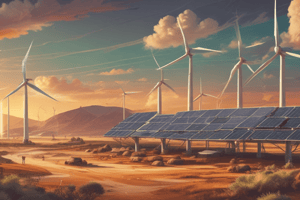Podcast
Questions and Answers
Which of the following are examples of non-renewable energy sources?
Which of the following are examples of non-renewable energy sources?
- Natural Gas (correct)
- Solar Power
- Wind Power
- Coal (correct)
Renewable energy sources are sustainable because they can be replenished.
Renewable energy sources are sustainable because they can be replenished.
True (A)
What is the main reason countries are seeking to reduce their reliance on non-renewable energy sources?
What is the main reason countries are seeking to reduce their reliance on non-renewable energy sources?
Global warming and environmental concerns
Renewable energy is always reliable because the sun always shines and the wind constantly blows.
Renewable energy is always reliable because the sun always shines and the wind constantly blows.
Hydroelectric power, wind power, and solar power are all examples of ______ energy sources.
Hydroelectric power, wind power, and solar power are all examples of ______ energy sources.
Which of the following is NOT a disadvantage of nuclear power?
Which of the following is NOT a disadvantage of nuclear power?
Match the following energy sources with their category:
Match the following energy sources with their category:
Which of the following is NOT a reason why countries may struggle to adopt renewable energy sources?
Which of the following is NOT a reason why countries may struggle to adopt renewable energy sources?
What is the primary source of energy used in nuclear reactors?
What is the primary source of energy used in nuclear reactors?
Nuclear power plants are often built in regions with ______ geological stability.
Nuclear power plants are often built in regions with ______ geological stability.
Developing countries tend to rely more heavily on renewable energy sources compared to developed countries.
Developing countries tend to rely more heavily on renewable energy sources compared to developed countries.
Match the following power station types with their primary siting requirements:
Match the following power station types with their primary siting requirements:
Explain one benefit of using renewable energy sources.
Explain one benefit of using renewable energy sources.
Flashcards
Renewable Energy Limitations
Renewable Energy Limitations
Renewable energy can be expensive, unreliable, and not universally applicable in developing nations.
Nuclear Power Characteristics
Nuclear Power Characteristics
Nuclear power is often considered renewable but uses a non-renewable resource, uranium, posing safety concerns.
Nuclear Reactor Function
Nuclear Reactor Function
Nuclear reactors generate heat through uranium fission to drive turbines for electricity production.
Nuclear Power Pros and Cons
Nuclear Power Pros and Cons
Signup and view all the flashcards
Power Station Siting
Power Station Siting
Signup and view all the flashcards
Non-renewable energy sources
Non-renewable energy sources
Signup and view all the flashcards
Examples of fossil fuels
Examples of fossil fuels
Signup and view all the flashcards
Renewable energy sources
Renewable energy sources
Signup and view all the flashcards
Hydroelectric power (HEP)
Hydroelectric power (HEP)
Signup and view all the flashcards
Global warming and fossil fuels
Global warming and fossil fuels
Signup and view all the flashcards
Energy use by development level
Energy use by development level
Signup and view all the flashcards
Challenges for renewable energy adoption
Challenges for renewable energy adoption
Signup and view all the flashcards
Self-sufficiency in energy
Self-sufficiency in energy
Signup and view all the flashcards
Study Notes
Energy Sources
- Non-renewable energy sources, also known as fossil fuels, are not sustainable.
- They take a long time to form from dead organisms.
- Fossil fuels will eventually run out.
- Non-renewables currently provide a large proportion of the world's energy.
Renewable Energy Sources
- Renewable energy sources can be replenished.
- They are obtained from natural resources like the sun, wind, or water.
- Examples include hydroelectric power, wind power, solar power, biofuels, and wave/tidal power.
- Using biofuels like fuelwood is renewable if the trees are reforested.
Differences in Energy Sources Between Countries
- Developed countries use more energy per capita.
- Their energy sources differ from developing countries.
- Developing countries rely more on resources concentrated in developed areas.
Why Countries Rely Less on Non-Renewables
- Non-renewable resources are not sustainable and will eventually run out.
- Global warming pressures nations to switch because fossil fuels contribute significantly to atmospheric pollution.
- Countries want to reduce reliance on imports.
Why Only Few Countries Use Renewable Energy
- Renewable energy is still in the early stages of development.
- Developing countries often cannot meet all their energy demands.
- Setting up renewable energy infrastructure is expensive.
- Renewable energy sources are sometimes unreliable.
- Renewable energy sources can be inefficient compared to non-renewable alternatives.
Nuclear Power
- Nuclear power is considered a unique energy source; it is a renewable energy source that uses uranium.
- Uranium is a non-renewable resource.
- Nuclear power can be controversial due to potential catastrophic disasters.
How a Nuclear Reactor Works
- Nuclear reactors, despite different designs, share similar basics.
- They use uranium and nuclear fission to generate heat.
- The heat drives turbines to generate electricity.
Benefits and Disadvantages of Nuclear Power
- Building nuclear power plants is expensive but once built, they are reliable and cheap, and clean and safe.
- Nuclear waste needs safe disposal, which poses a risk to the environment due to radioactivity for hundreds of years.
- Nuclear power plants create jobs for many people.
- Nuclear plants can be built in remote areas to reduce dangers to health.
- Most countries need to import uranium for their nuclear power plants.
Siting of Power Stations
- Most power stations need to be near bodies of water for cooling steam.
- They usually need to be relatively close to urban areas for a workforce.
Studying That Suits You
Use AI to generate personalized quizzes and flashcards to suit your learning preferences.





